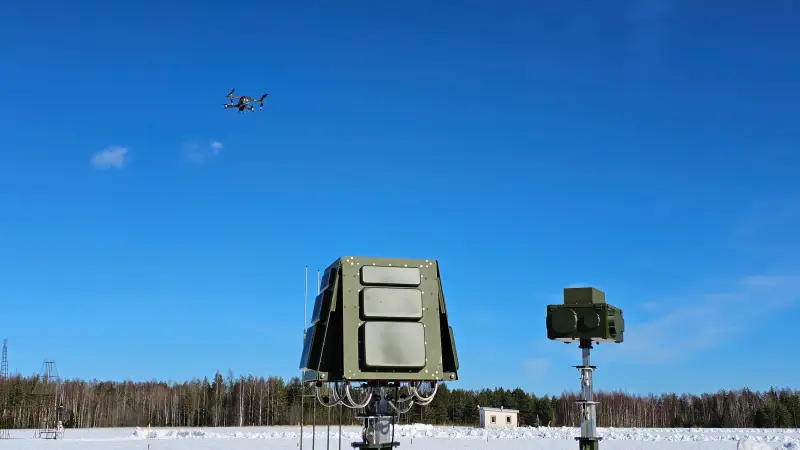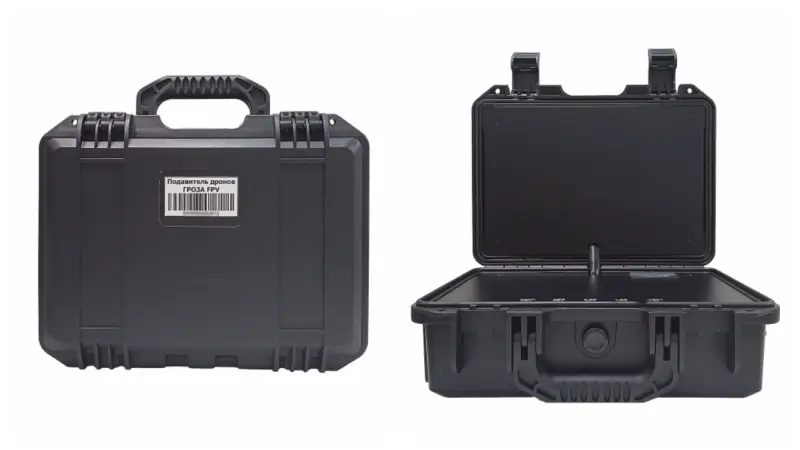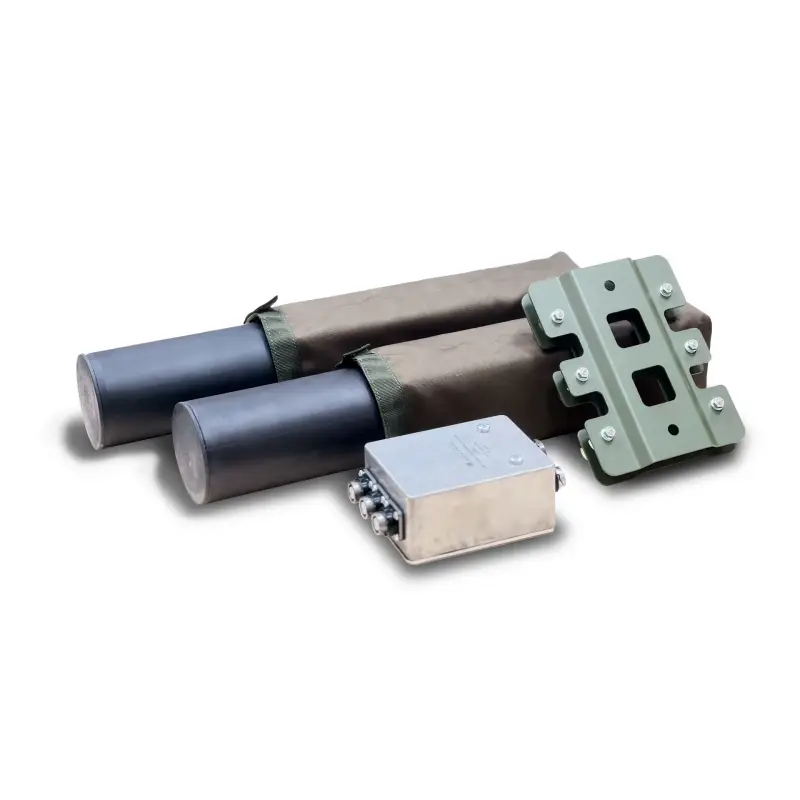Specialized electronic warfare systems to combat FPV drones

Elements of the Serp-VS5 complex. Photo "Ruselectronics"
Having depleted their arsenals and lost traditional fire weapons, Ukrainian formations are widely using disposable strike FPVs against our troops.Drones. To combat such a threat, various electronic and fire weapons are used. In particular, various electronic warfare systems capable of suppressing incoming UAVs are being actively developed and produced. Some such products have already reached mass production and adoption by the troops.
In stationary version
At the end of the tenth years, the Vector Research Institute (St. Petersburg) from Ruselectronics (Rostec State Corporation) presented the Serp electronic warfare system, designed to suppress unmanned radio channels aviation systems Subsequently, this project grew into a whole family of complexes, including several samples.
The latest models in the line are “Serp-VS5” and “Serp-VS6”, presented last year. These are stationary complexes designed for long-term operation in one position and covering a nearby area from possible attacks. The complexes are capable of fighting UAVs of popular models that use radio communications and satellite navigation. FPV-drones are also included in the number of suppressed targets.

Complex "Groza.04.K". Photo "Rostec"
The Serp-VS5/6 complexes have a similar architecture. An antenna module is placed on a tripod or telescopic mast, connected to the control panel using a cable. The antenna module has four blades directed in different directions and is also equipped with the necessary electronics. The complex independently detects radio signals from air targets, determines the direction to the detected object and suppresses it with interference.
The latest models of “sickles” operate in several ranges from 300 MHz to 5,8 GHz. The signals of satellite navigation systems and radio control/data transmission channels are clogged with interference. The suppression range of UAVs, depending on various factors, can reach 5 km.
All main modifications of the Serp-VS complex were tested in test conditions and confirmed the design characteristics. They have been brought to mass production and are shipped to customers. According to known data, a certain number of such devices have already been supplied to the troops engaged in the Special Operations, and have also been purchased by commercial customers to protect various objects.
In August 2023, NPO Kvant (Veliky Novgorod), part of the Radioelectronic Technologies concern of the Rostec state corporation, began developing the Groza.04.K electronic warfare system. The work was entrusted to a group of five young specialists, and they completed the new project in the shortest possible time. Already in the fall, the first batch of new products was transferred to the armed forces for testing under Special Operations conditions. By now, “Thunderstorm.04.K” has reached a full-fledged series.

Details of the Triton complex - noise generators (cylindrical devices) and a control unit. Photo "PPSh Laboratory"
Rostec reported that the Groza.04.K product is intended to search for and suppress control channels and satellite navigation signals. The design of the complex uses some fundamentally new solutions, the nature of which, however, is not disclosed. The characteristics and functions of the product also remain unknown.
Armored vehicle protection
The enemy is most actively trying to use FPV drones against our armored vehicles. The answer to this was additional anti-cumulative and other means of protection, as well as specialized electronic warfare systems. To date, several similar systems have been developed and tested in the army, and new ones can be expected.
One of the first to appear was the Triton jamming system, developed by the PPSh Laboratory (St. Petersburg). The design of this complex is made taking into account the need for installation on self-propelled platforms with all their features and limitations. During operation, Triton creates an interference “dome” around the carrier, suppressing the control channels of FPV drones within a radius of at least hundreds of meters.

Tank T-72B3 in the 2022 version with additional protective equipment. A noise generator from Triton is installed on the visor. Photo Vitalykuzmin.net
The minimum configuration of the Triton includes a noise generator of the LGSh-608/609 type, mounted outside the carrier armored vehicle, a power supply, control and monitoring unit, as well as a control panel and connecting cables. The complex is connected to the carrier's on-board power supply with a voltage of 24 V and consumes no more than 180 W. During operation, continuous omnidirectional interference is generated at several frequencies from 860 to 928 MHz.
Another development last year in the field of electronic warfare for equipment was the Volnorez complex. It has a modular architecture and can be produced in different configurations and with different performance characteristics. At the same time, the design of the complex modules greatly simplifies the process of installation and preparation for operation.
The main element of the Breakwater is the antenna module in a characteristically shaped housing. The module has a magnetic base, with which it can be installed on any metal part of the carrier without additional fasteners. Up to 8 modules are connected to the control panel using cables. The module has an omnidirectional radiation pattern and can operate in one of 18 frequency ranges. Radiation power – up to 30 W.

Emitters of the "Breakwater" complex on the roof of a car involved in the Special Operation. Photo by KB "Volnorez"
Last fall, the 3MX company from St. Petersburg introduced the Sania armored vehicle protection system. This product includes a jammer module, a UAV detector and controls. During operation, these devices detect and jam the radio channels of unmanned systems.
The main module of the Saniya complex is a container-case with a set of external antennas. The work is carried out automatically without operator intervention. Radio communications of a typical FPV drone are detected at ranges of 1,5 km. Depending on different conditions, effective suppression is achieved from a distance of about 1 km.
Equipment at the front
In the shortest possible time after the emergence of a new threat in the form of FPV drones, our industry created a number of new specialized electronic warfare systems to combat them. With the assistance of the Ministry of Defense and volunteer organizations, electronic warfare systems of almost all types have already entered the troops and are being tested by practice in the Special Operation zone. Such devices protect equipment and positions, confirm their characteristics and help gather experience for further improvement of designs and application tactics.

Suppressors from the Saniya system. Photo 3MX
Several anti-FPV drone systems have reached mass production. The “Breakfast” complex should probably be considered the most successful in its class. Last fall it became known about the beginning of the installation of such products on existing ones in the troops. Tanks, and the Ministry of Defense subsequently confirmed this information. If this is carried out by order of the defense department, then the Breakwater could become widespread with corresponding positive consequences for the safety of armored vehicles and their crews.
Development organizations collect information on the use of their electronic warfare systems and improve their design, improve characteristics, etc. In addition, completely new products are being developed, both within existing families and completely new ones. It is obvious that similar processes will continue in the future, thanks to which the army will receive improved systems or new products, and with them improved protection against current threats.
Obvious results
In recent months, a number of characteristic complaints have been heard from the Ukrainian side. The enemy is seriously concerned about the superiority of the Russian army in the quantity and quality of UAVs of all classes. In addition, it cannot effectively use its unmanned aircraft due to the active operation of electronic warfare systems. FPV drones simply cannot break through to Russian equipment and fall in the distance, which leads to the useless loss of the drone.
Such problems on the enemy’s side are clear confirmation of the high effectiveness of Russian defense systems. Serial electronic warfare systems of a number of models successfully protect our equipment and objects from enemy attacks. Thus, they help Russian troops preserve forces and means to more effectively continue the demilitarization of the Kyiv regime.
Information